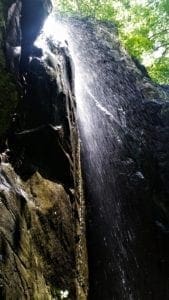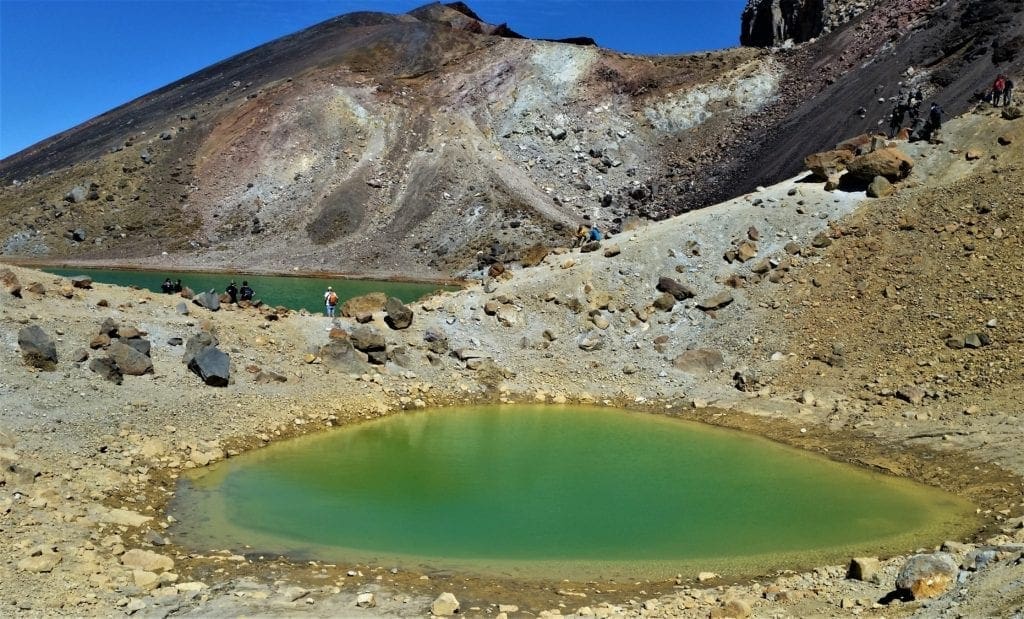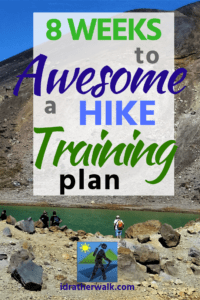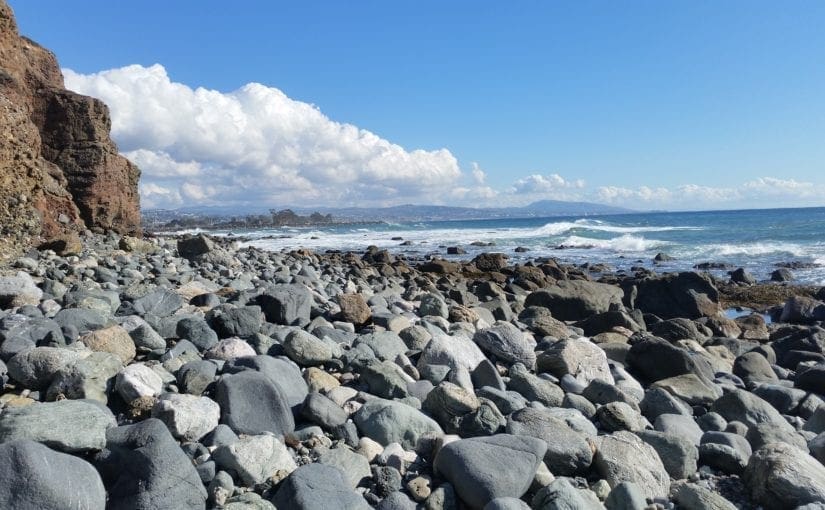Most recently updated February 3rd, 2023
This is the time of year when everyone resolves to somehow change their lives for the better in the coming year.
This past year, my goals were pretty easy to define – at least for the first couple of months.
You see, I’d been battling a really vicious head and chest cold – since late November.

Then, that turned into an infection (of lung and sinus type) for a few weeks and that went away but the original cold came back!
This illness plus inclement weather and Holiday shenanigans kept me from doing my usual basic maintenance workouts or scheduling as many hikes as usual.
AND – here’s where the goals come in – I’d planned a hiking trip to New Zealand for early Spring.
So, my goal was to be healthy and strong enough to do all the things in New Zealand without any struggle.
I had about 8 weeks to make that happen. The good news is I did the training, went to new Zealand and had an awesome time hiking the Tongariro Alpine Crossing.
I squeaked back into the US literally hours before they shut down international travel to New Zealand.
Fast forward to now, and we’ve had some version of COVID-19 lockdown in place, limiting our activities, since I got back home in March.
That Man and I had planned a trip to Hawaii – Kauai, to be exact – for April that had to be rescheduled for this coming winter’s Holiday season.
That’s where my training program “8 Weeks to Awesome” – or Auckland, to be specific – comes back into play.
I’ve got to get back on the plan to be ready for the Hawaii trip – assuming we’re allowed to go this time. (As of this writing, prohibitive quarantines and testing requirements are still in place for out of State visitors…)
If you’re looking for a way to get back into shape before the Holidays – even if you don’t have a big trip coming – maybe you’d like to do it with me!
NOTE: I’ve updated this for 2022 with a new post you can see here. It’s the same workout, but with more current commentary 🙂

Did I mention there was going to be even more swimming on this trip than the New Zealand trip?
Aack!!
I also still want to lose about 5 lbs, but I figure just returning strictly to my anti-Asthma diet after all of the lockdown/depression eating will be a good start.
That, plus remedial training (with a little bit of Hawaii-specific bits thrown in) should take care of it.
If the diet and training don’t work, I’ll need to find one of those old swim outfits with the leggings and the parasol….
But, not to worry!
I have a plan to get back into fighting form and rock the hikes AND a modern swimsuit, too. Maybe you’d like to join me…
Some of my posts contain affiliate links. If you make a purchase through an affiliate link, I will receive a small payment at no additional cost to you. As an Amazon Associate, and other marketing affiliations, I earn from qualifying purchases. See full Disclosure page here.
How to Train for Hiking
We’re planning for some longer hikes – and one specific one – with high elevation gain, on the trip to Kauai.
Long-distance hiking, even if its just a dayhike, can be a pretty intense athletic activity – so we’ll need to train for it.

It’s always a good idea to do some training in advance to be able to do a significant hike and make it back to the trailhead without injury – and hopefully be in good enough shape to enjoy the experience!
Preparations for the hike will include physical training, research of the terrain you’ll be hiking on, and learning how to use your gear.
In addition to actually getting out on the trail, there are some indoor exercises that can help you get ready.

Get The FREE PDF!
Everything that you need to start your 8 Week training is included in this post.
But it’s a long read and inconvenient to refer to online while you’re training.
For your convenience, you can click here to sign up and download your FREE “8 Weeks to Awesome” PDF file.
Then you can print it out and refer to your plan anytime you want. Happy training! LJ
Aerobic/Cardio Exercises

Aerobic/cardio exercises get the heart pumping, which provides oxygenated blood to the muscles.
Aerobic exercises are perfect for hiking because they train your heart to allow you to keep going for long period of time.
Of course, eventually you’ll get tired, but this kind of training will help keep you going strong through your whole hike.
Examples of aerobic/cardio exercises include dancing, hiking, walking, spinning, and kickboxing.
Resistance/Strength Training
Resistance training will build your muscular strength and boost your muscular endurance.

Building up the muscles in your legs and arms is important for long-distance hiking, due to the intensity of the activity.
Strength training doesn’t have to be done with weights in a gym.
Instead, you can train using your own body weight.
These types of exercises include push-ups, squats, lunges, crunches, and pull-ups.
Shorter length hikes with a heavy pack is also a good form of strength training.
Train For the Terrain
All hiking trails are different and getting to know the trail before you go for a long-distance hike is very important.
For instance, you’ll want to know if you’ll be hiking on the flat or at a steep incline, or on a rocky surface or snow, etc.
If you can, you should train in similar terrain as what you’ll see on your long distance hike.
Another great reason for training on similar terrain is it will help you to pick out what kind of gear you’ll need for your hike.

Practice With Your Gear
Once you know what kind of terrain and weather you’ll be dealing with, it’s a good idea to break your gear in, and hike with it a few times before you go – especially if you’re getting new boots for the hike.
If you’re unsure of what you might need, take a look at my Gear page, or my Dayhike Gear Guide for some ideas.
If you’re brand new to hiking, check out the Hiking Tips page for some good pointers to get started.
Weekly Training Plan for Hikers
You may already have a maintenance workout schedule going that keeps you in generally good shape. You can add to that or modify it to focus on areas that need building up for hiking.
If you’re just starting out – or coming back from an extended illness or forced inactivity – below is a good weekly training plan for hiking beginners.
You can start at your own level and go from there.

From week to week, you’ll build on the progress you’ve made in the previous weeks.
- Weeks 1-3: Strength-training 3 days per week, 1 hour/session.
- Weeks 4-6: Keep doing the Strength Training, and add one additional endurance workout every week for 45 minutes at moderate intensity (like jogging or hiking).
- Weeks 7-8: Continue Strength Training, increase the length of your weekly endurance workouts to 1.5 to 2 hours, and add 1 day of high-intensity exercise with high output but less weight (like speed hiking).
- Begin and end each workout with a 10 minute stretching routine.
So, at the end of the 8 weeks, your weekly training will include:
- (3) Strength training workouts,
- (2-3) 1.5-2 hour moderate endurance hiking or jogging workout, and
- (1) high intensity workout – like speed hiking.
- Stretch every day
| Sample Weekly Workout Schedule | ||
| Monday | Strength | Stretch |
| Tuesday | Endurance | Stretch |
| Wednesday | Strength | Stretch |
| Thursday | Endurance | Stretch |
| Friday | Strength | Stretch |
| Saturday | Hi Intensity | Stretch |
| Sunday | Endurance | Stretch |
The above is a basic weekly maintenance schedule (after an 8 week buildup), which uses a once per day moderate workout to stay in reasonably good shape.
To train for a specific hike (like I am) you’ll want to already be at a maintenance schedule, then add some training hikes tailored to your specific hiking goal.
Hiking to Get in Shape for Hiking

The best way to train for a hike is to go hiking.
That said, you don’t need to do a training hike every day of the week.
You should aim for one longer training hike per week, with walking/jogging and strength-building throughout the rest of the week (see weekly maintenance training schedule above).
If the weather is bad, or you don’t have any hills around, you can do this kind of training on a stair-climber, treadmill at max incline, or actually going up and down the stairs wearing your pack.
If you can, add an additional weekly shorter hike with some elevation gain and a heavy pack to be one of your weekly strength building workouts.
Your Unique Hiking Training Plan
Your current fitness level shouldn’t define your adventures.
Instead, acknowledge your current fitness level, decide where you want to be, and create a plan to bridge the gap between the two.
If you have a specific goal in mind, you can use that as an end point to help you plan a series of hikes that will prepare you for your goal.
Start with the goal distance and elevation gain on week 8 (the last week of your training) and work backward for 8 weeks, starting from the goal hike length and elevation to your current fitness at Week 1.
As you train, also try to work up to the pack weight you will be hiking with on your goal hike.
On my New Zealand trip (with my favorite adventure travel company) the hardest day of hiking was a 12 mile hike in Tongariro National Park, so I did my training plan with that hike in mind.

For the Hawaii trip, we plan to do a lot of hiking – but none as long as the Tongariro hike.
That said, it’s good to train for a goal and we do have one: the Kalalau Trail.
Kauai’s Kalalau Trail
Kauai’s 11 mile (one way) Kalalau Trail leads from Ke’e Beach to Kalalau Beach along the Na Pali Coast.
The Kalalau Trail is definitely a “bucket list” hike for those of us who live to hike the world. 🙂
Traversing five valleys, the Trail terminates at Kalalau Beach, providing the only land access to this rugged stretch of Kauai’s coast.
We plan to do only a portion of this hike to keep it to a day hike – the 5.5 miles from Ke’e Beach to Hanakoa – to make it 11 miles round trip. Elevation gain will be about 5000 feet.
For experienced hikers in excellent shape, they recommend allowing for a long day (8+ hours) to complete this section. (Day hikes on this trail beyond Hanakoa are not recommended.)

After a summer of local hiking (packing all of my water for the day due to COVID-19 restrictions) – doing Virginia’s Triple Crown hike in July, and summiting Mt. LeConte in the Smoky Mountains in August – I’m not starting from zero.
That said, I really need to stay in shape – not so much for the hike length, but for sure the 5000 feet elevation gain.
If we give ourselves 8 weeks to train to comfortably do this day hike, the Tongariro hike (or something like it), the training plan hike progression would look something like this:
| Week | Miles | Elevation / Pack Weights |
| 1 | 5.5-6mi, Lake Crabtree | 100 ft / No extra water |
| 2 | 6-7mi, Loblolly Trail | 500 ft / 2 extra bottles |
| 3 | 6.5mi, Co Mill Trail | 1,000 ft/ 3 extra bottles |
| 4 | 7.2mi, Sycamore Trail | 1500 ft/ 3 extra bottles |
| 5 | 8-9mi, Loblolly-Schenck | 2000 ft/4 water bottles |
| 6 | 8-9, Co Mill-Sycamore Loop | 2500 ft/4 water bottles |
| 7 | 10-13mi, Co Mill-Big Lake | 3000 ft/ 5 water bottles |
| 8 | 12-14mi, Loblolly-NCMA | 3500 ft/ 5 water bottles |
NOTE: For training purposes, to create extra stress to simulate more steep elevation gain than is available locally, I’ve added more water bottles to the pack each week, starting with a base weight of 10 lbs. (A 500ml/16 oz water bottle weighs around 1.1 lbs.)
If you’re training for strength as well as endurance, you can do that at the gym and/or add a shorter hike each week with increasing pack weights.
This is especially helpful if you know you’ll be hiking with a heavy pack and need to work up to it.
In my case, I know I’ll only be hiking with a day pack, so I’m only training with a pack weight of up to 30 lbs.
These strength building hikes are not about speed, but I would recommend maintaining at least a 2.5-3mph pace to get the results you want.
| Week | Miles | Extra Weight |
| 1 | 5mi, Co Mill-MUT | 10lbs |
| 2 | 5-6mi, NCMA-Meredith | 10lbs + 2 bottles |
| 3 | 5mi, Lake Pine-Annie Jones | 15lbs |
| 4 | 5-6mi, Bond Park Lk trail | 15lbs + 4 bottles |
| 5 | 6mi, Lake Crabtree | 20lbs |
| 6 | 6mi, Old Reedy Crk to Warren Cemetery | 20lbs + 2 bottles |
| 7 | 6.5mi, Loblolly | 20lbs + 4 bottles |
| 8 | 6.5mi, Co Mill | 30lbs |
In my experience, it’s the elevation gain, not the mileage, that people find most difficult. So be sure to get some training hiking up hill.
Train hard, but don’t push yourself so quickly that you get injured. An injury will set you back, and maybe even cause you to cancel a hiking trip.
If you find you can already hike your allotted miles comfortably, then you might add miles and elevation gain faster than laid out in the program.
NEW: Track Your “Awesome” Progress at Home!

You’ll get instructions and three printable trackers:
-
- Your Hike Plan Worksheet
- Daily & Weekly Workouts
- Weekly Meals tracker
A download link in your confirmation email let’s you get started right away. Happy training! LJ
This is a very moderate training program, but everyone progresses differently.

Come Out for a Hike
The hikes I’ve listed are actual local hikes that I’ll be posting to my hiking Meetup group. You can sign up on Meetup if you’d like to hike with me. 🙂
If you’re not local, you can follow the plan with equivalent hikes in your area.
Is Hiking Really Good for Fitness?
Hiking is the single most popular form of exercise in the world, and the health benefits are tremendous.
Walking and hiking can be used as your sole fitness routine and can even lead to weight loss if you do enough of it.
While walking a mile isn’t going to burn as many calories as running a mile, hiking hills with a full pack can burn more.
Here are some of the benefits you’ll get from hiking for fitness:
1. Burn Calories
Based on the increase of heart and breathing rates, the uphill portion of hiking will burn as many calories as a moderately-paced run.
2. You Can Hike Anywhere
Hiking can be done anywhere. If you don’t have access to a hill, walking on a treadmill at an exaggerated incline will create a similar experience, though it’s much more fun to get outside.
3. It Can Be Social
If you live in an urban area, hiking can be a great weekend activity. Instead of watching a movie or hanging out in a pub, why not take a walk outdoors with your family and friends?
4. Hiking is a Total-Body Workout
When you hike, your core will be more engaged to keep your body stable while going over rough terrain, and your butt, thigh and calf muscles will be burning by the time you’re through. And because it’s hard cardiovascular work, your heart and lungs will get a great benefit as well.
5. Benefits of Green Exercise
Have you ever noticed that you feel happier and more energetic when you’re out on the trail, or even just sitting in a park? Research shows that hiking and other Green Exercise can reduce stress and increase happiness.
How To Get Started
Find some hills in your local area and have at it. This doesn’t need to be complicated.
Remember to dress comfortably and wear sturdy footgear with non-slip soles.
Start with a small hike and see how you feel about it before you tackle something more ambitious.
Bringing water and a cell phone is a good idea. Also, you might want to leave a note. 🙂
But mostly, get out there and have fun! Hiking is an incredibly rewarding activity that engages body, mind and spirit.
By following a training plan that increases your hiking mileage and elevation over time, you’ll build the strength and endurance you need to take on any trail you set your sights on.

I hope this post has been helpful and motivational for you! If you have any questions or comments, please drop me a note and I’ll get back to you as quickly as I can.
During the training for New Zealand, I made Training log posts as I made my 8-week training journey. To see them go to my Training Log.
I hope they’ll be helpful- or at least amusing! 🙂
Unfortunately, after updating this post I suffered a leg injury. 🙁
Read here about how I trained back after an injury. Maybe you’ll get some ideas!
For more posts with ideas for getting fit and healthy, go to the Fitness & Wellness page.
Thanks for stopping by – see you next time! LJ
To Get New Idratherwalk Posts
sent directly to your inbox (how convenient!) Click this Button
If you enjoyed this post, please share it:



LJ has spent much of her free time as a single Mom – and now as an empty-nester – hiking in the US and around the world. She shares lessons learned from adventures both local and in exotic locations, and tips on how to be active with asthma, plus travel, gear, and hike planning advice for parents hiking with kids and beginners of all ages. Read more on the About page.

